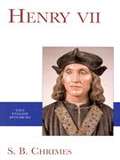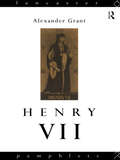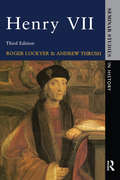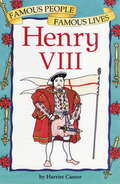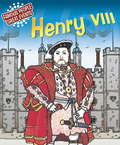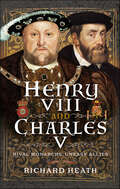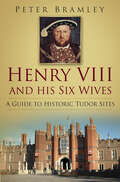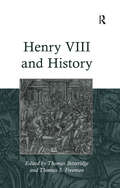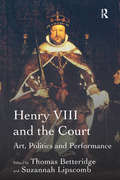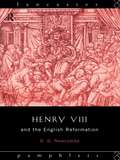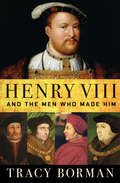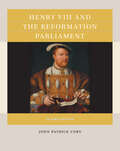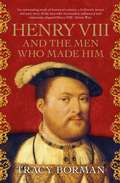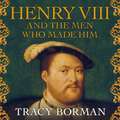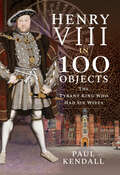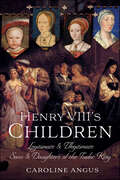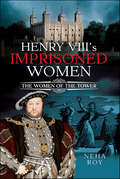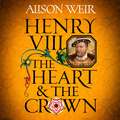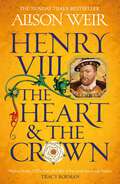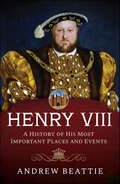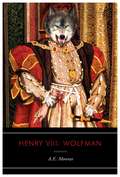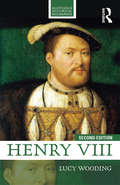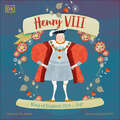- Table View
- List View
Henry VII
by Stanley B. ChrimesFounder of the Tudor dynasty, Henry VII was a crucial figure in English history. In this acclaimed study of the king's life & reign, the distinguished historian S. B. Chrimes explores the circumstances surrounding Henry's acquisition of the throne, examines the personnel & machinery of government, & surveys the king's social, political, & economic policies, law enforcement, & foreign strategy. This edition of the book includes a new critical introduction & bibliographical updating by George Bernard.
Henry VII (Lancaster Pamphlets)
by Alexander GrantThe importance of Henry VII is the subject of heated debate. Did his reign mark the start of a new era, or was its prevailing characteristic continunity with the past? The pamphlet:· emphasizes the lasting political stability established during the reign· demonstrates the difference between Henry's policies and those of the Yorkists· shows how successors built on Henry's legacy· argues that victory at Bosworth in 1485 can be seen as initiating a genunine 'Tudor revolution in government'.
Henry VII (Seminar Studies)
by Roger Lockyer Andrew ThrushThis study reassesses the policies of the founder of the Tudor dynasty and shows how Henry worked within existing traditions rather than breaking with the past. Every facet of the reign is considered including the nature of government - both at central and local level, financial policy, relations with the Church, foreign policy, economic affairs and concludes by assessing Henry as a 'new monarch'.
Henry VIII (Famous People, Famous Lives #12)
by Harriet CastorExciting stories about famous people, outlining their lives and the important events which made them memorable. Every page features easy-to-follow text and a black-and-white line drawing to help bring these events to life. Each title gives further facts about the famous person and the times in which he or she lived, plus a comprehensive time line detailing key dates. Henry VIII is an exciting tale of kings and queens, jousting knights and grisly executions. It explains how Henry took power away from the Church in his quest for an heir to inherit his kingdom.
Henry VIII (Famous People, Great Events #5)
by Harriet CastorExciting stories about famous people, outlining their lives and the important events which made them memorable. Every page features easy-to-follow text and a black-and-white line drawing to help bring these events to life. Each title gives further facts about the famous person and the times in which he or she lived, plus a comprehensive time line detailing key dates. Henry VIII is an exciting tale of kings and queens, jousting knights and grisly executions. It explains how Henry took power away from the Church in his quest for an heir to inherit his kingdom.
Henry VIII and Charles V: Rival Monarchs, Uneasy Allies
by Richard HeathKing Henry VIII and Emperor Charles V both ruled for almost forty years at a time when momentous changes in society, politics and religion were taking place in England and across Europe. Richard Heath takes a fresh look at these two individuals and the importance of their relationship in determining both their immediate policies and the future of their lands. Although always rivals for status, Henry and Charles, despite their very different temperaments, had much in common. Both had been brought up as devout Christians and in the chivalric tradition. Ties between their lands (by 1520 Charles was Holy Roman Emperor as well as ruling Spain, the Low Countries and much of Italy) were close. There were alliances against a common enemy, France, valuable trading links and a personal connection – Henry was married to Charles’ aunt, Catherine of Aragon. The book provides a clear account of their complex and ever-changing relationship, both personal and political. It reveals the goodwill that existed between them, particularly during Emperor Charles’ lengthy state visit to England in 1522. It also shows how this proved impossible to maintain once Henry decided to end his marriage to Catherine and his subsequent rejection of papal authority. On the occasions when they planned military action together their alliance collapsed in mutual recriminations. Yet they were officially at war for only a few months and their armies never faced each other. The duplicitous world of international diplomacy, with dynastic marriages, fine words and broken promises, provides the backdrop to this fascinating story. In their search for honor and dynastic security, so important to both monarchs, the decisions of one could rarely be ignored by the other.
Henry VIII and His Six Wives: A Guide to Historic Tudor Sites
by Peter BramleyIn his hunt for a male heir Henry VIII broke with Rome, instigated the Reformation and the Dissolution of the Monasteries, and acquired six wives successively. Of these, two were executed, a chilling first in English history. From these tumultuous events a surprising number of historic sites linked to the Tudors survive, accessible now through this beautifully illustrated book. The guidebook is arranged by region and covers England and a little of Europe. With directions to each site, along with full details of the Tudor events and personalities linked to them, this guidebook will appeal to all who find visiting an historic site brings life and colour to the study of history.
Henry VIII and History
by Thomas S. FreemanHenry VIII remains the most iconic and controversial of all English Kings. For over four-hundred years he has been lauded, reviled and mocked, but rarely ignored. In his many guises - model Renaissance prince, Defender of the Faith, rapacious plunderer of the Church, obese Bluebeard-- he has featured in numerous works of fact and faction, in books, magazines, paintings, theatre, film and television. Yet despite this perennial fascination with Henry the man and monarch, there has been little comprehensive exploration of his historiographic legacy. Therefore scholars will welcome this collection, which provides a systematic survey of Henry's reputation from his own age through to the present. Divided into three sections, the volume begins with an examination of Henry's reputation in the period between his death and the outbreak of the English Civil War, a time that was to create many of the tropes that would dominate his historical legacy. The second section deals with the further evolution of his reputation, from the Restoration to Edwardian era, a time when Catholic commentators and women writers began moving into the mainstream of English print culture. The final section covers the twentieth and twenty-first centuries, which witnessed an explosion of representations of Henry, both in print and on screen. Taken together these studies, by a distinguished group of international scholars, offer a lively and engaging overview of how Henry's reputation has been used, abused and manipulated in both academia and popular culture since the sixteenth century. They provide intriguing insights into how he has been reinvented at different times to reflect the cultural, political and religious demands of the moment; sometimes as hero, sometimes as villain, but always as an unmistakable and iconic figure in the historical landscape.
Henry VIII and the Court: Art, Politics and Performance
by Suzannah LipscombAfter 500 years Henry VIII still retains a public fascination unmatched by any monarch before or since. Whilst his popular image is firmly associated with his appetites - sexual and gastronomic - scholars have long recognized that his reign also ushered in profound changes to English society and culture, the legacy of which endure to this day. To help take stock of such a multifaceted and contested history, this volume presents a collection of 17 essays that showcase the very latest thinking and research on Henry and his court. Divided into seven parts, the book highlights how the political, religious and cultural aspects of Henry's reign came together to create a one of the most significant and transformative periods of English history. The volume is genuinely interdisciplinary, drawing on literature, art history, architecture and drama to enrich our knowledge. The first part is a powerful and personal account by Professor George W. Bernard of his experience of writing about Henry and his reign. The next parts - Material Culture and Images - reflect a historical concern with non-documentary evidence, exploring how objects, collections, paintings and buildings can provide unrivalled insight into the world of the Tudor court. The parts on Court Culture and Performance explore the literary and theatrical world and the performative aspects of court life, looking at how the Tudor court attempted to present itself to the world, as well as how it was represented by others. The part on Reactions focuses upon the political and religious currents stirred up by Henry's policies, and how they in turn came to influence his actions. Through this wide-ranging, yet thematically coherent approach, a fascinating window is opened into the world of Henry VIII and his court. In particular, building on research undertaken over the last ten years, a number of contributors focus on topics that have been neglected by traditional historical writing, for example gender, graffiti and clothing. With contributions from many of the leading scholars of Tudor England, the collection offers not only a snapshot of the latest historical thinking, but also provides a starting point for future research into the world of this colourful, but often misrepresented monarch.
Henry VIII and the English Reformation
by David G NewcombeWhen Henry VIII died in 1547 he left a church in England that had broken with Rome - but was it Protestant? The English Reformation was quite different in its methods, motivations and results to that taking place on the continent.This book: * examines the influences of continental reform on England * describes the divorce of Henry VIII and the break with Rome * discusses the political and religious consequences of the break with Rome * assesses the success of the Reformation up to 1547 * provides a clear guide to the main strands of historical thought on the topic.
Henry VIII and the Men Who Made Him: The Secret History Behind The Tudor Throne
by Tracy BormanThe acclaimed historian presents a &“beautifully perceptive and dynamic reassessment of Henry VIII…in this highly engrossing biography&” (Booklist, starred review). Henry VIII is best known for his tempestuous marriages and the fates of his six wives. But his reign and reputation were hugely influenced by his confidants, ministers, and even occasional rivals—many of whom have been underplayed in previous biographies. Exploring these relationships in depth, Tracy Borman offers a fresh perspective on the legendary king, revealing surprising contradictions in his beliefs and behavior. Henry was capable of fierce but seldom abiding loyalty, of raising men up only to destroy them later. He loved to be attended by boisterous young men like his friend Charles Brandon, who shared his passion for sport. But the king could also be diverted by men of intellect, culture, and wit, as his longstanding interplay with Cardinal Wolsey and his reluctant abandonment of Thomas More attest. Eager to escape the shadow of his father, Henry was easily led by male advisors early in his reign. In time, though, he matured into a profoundly paranoid and ruthless king. Recounting the great Tudor&’s life and signal moments through the lens of his male relationships, Henry VIII and the Men Who Made Him sheds fresh light on this fascinating figure.
Henry VIII and the Reformation Parliament (Reacting to the Past)
by John Patrick CobyHenry VIII and the Reformation Parliament transforms students into English lords and commoners during the tumultuous years of 1529 to 1536. Cardinal Wolsey has just been dismissed as lord chancellor for failing to obtain an annulment of King Henry’s marriage to Catherine of Aragon. Thomas More, the humanist author of Utopia, is named as Wolsey’s replacement. More presides over Parliament, which the king has summoned in the hope that it somehow will find the means to invalidate his marriage, thus freeing him to marry his new love, Lady Anne Boleyn. Matters of state also apply, because Henry has no male heir to carry on the Tudor line, and Queen Catherine has passed her childbearing years. But will Parliament be content with solving the king’s marital and dynastic problems? For there are some in Parliament who wish to use the royal divorce to disempower the English church, to sever its ties to papal Rome, and to change it doctrinally from Catholicism to Lutheranism. Others, however, oppose the divorce, oppose secular supremacy and independence from Rome, and oppose this heretical creed filtering in from the continent. More is their leader, for as long as he can survive. Thomas Cromwell, reputed a Machiavellian, leads the king’s party. The king himself is ambivalent about the reformation unleashed by his “great matter,” as the divorce campaign is called, and so the conservatives are loosed to prosecute reformers as heretics, while the reformers are loosed to prosecute conservatives as traitors. Meanwhile, outside England sits the greatest power in all of Europe, the Holy Roman Empire under King Charles V of Spain — who happens to be the nephew of Catherine! How will the emperor respond to this effort to put aside his aunt?
Henry VIII and the men who made him: The secret history behind the Tudor throne
by Tracy Borman'An outstanding work of historical artistry, a brilliantly woven and pacy story of the men who surrounded, influenced and sometimes plagued Henry VIII.' Alison WeirHenry VIII is well known for his tumultuous relationships with women, and he is often defined by his many marriages. But what do we see if we take a different look? When we see Henry through the men in his life, a new perspective on this famous king emerges.Henry's relationships with the men who surrounded him reveal much about his beliefs, behaviour and character. They show him to be capable of fierce, but seldom abiding loyalty; of raising men only to destroy them later. He loved to be attended and entertained by boisterous young men who shared his passion for sport, but at other times he was more diverted by men of intellect, culture and wit. Often trusting and easily led by his male attendants and advisers during the early years of his reign, he matured into a profoundly suspicious and paranoid king whose favour could be suddenly withdrawn, as many of his later servants found to their cost. His cruelty and ruthlessness would become ever more apparent as his reign progressed, but the tenderness that he displayed towards those he trusted proves that he was never the one-dimensional monster that he is often portrayed as. In this fascinating and often surprising new biography, Tracy Borman reveals Henry's personality in all its multi-faceted, contradictory glory.
Henry VIII and the men who made him: The secret history behind the Tudor throne
by Tracy BormanTracy Borman, author of the bestselling biography Thomas Cromwell, takes us behind the scenes of Henry VIII's court and sheds new light on the most notorious Tudor monarch through the fresh perspective of his male relationships.Henry VIII is well known for his tumultuous relationships with women, and he is often defined by his many marriages. But what do we see if we take a different look? When we see Henry through the men in his life, a new perspective on this famous king emerges...Henry's relationships with the men who surrounded him reveal much about his beliefs, behaviour and character. They show him to be capable of fierce, but seldom abiding loyalty; of raising men only to destroy them later. He loved to be attended and entertained by boisterous young men who shared his passion for sport, but at other times he was more diverted by men of intellect, culture and wit. Often trusting and easily led by his male attendants and advisers during the early years of his reign, he matured into a profoundly suspicious and paranoid king whose favour could be suddenly withdrawn, as many of his later servants found to their cost. His cruelty and ruthlessness would become ever more apparent as his reign progressed, but the tenderness that he displayed towards those he trusted proves that he was never the one-dimensional monster that he is often portrayed as. In this fascinating and often surprising new biography, Tracy Borman reveals Henry's personality in all its multi-faceted, contradictory glory.(P)2018 Hodder & Stoughton Limited
Henry VIII in 100 Objects: The Tyrant King Who Had Six Wives (In 100 Objects Ser.)
by Paul Kendall“Full of excellent and pristine photographs of many items and places that shaped the life of one of England’s most fascinating kings . . . five stars.” —UK HistorianHenry VIII is one of history’s most memorable monarchs. Popularly known for his six wives, and the unfortunate fate which befell Anne Boleyn and Catherine Howard, Henry initiated many reforms and changes which still affect our lives today.In this engaging and hugely informative book, the author takes us on a journey across England, from Deal Castle on the south coast, to Tower Green where Anne Boleyn and Catherine Howard lost their heads, and far north to Rievaulx Abbey in Yorkshire. Along the way we see places where Henry stayed, where the Mary Rose, one of his great warships, was recovered, the homes of his consorts, and Smithfield where prominent individuals convicted of heresy were burned at the stake. Travel, then, not just across the country, but also back in time through 100 objects from the days of the second Tudor monarch—Henry VIII.“Because the items and places are so varied, the book has a wealth of information and the author has done a lot of research to present as much detail as possible . . . [a] really well-written and illustrated book about the people, places and objects that would have been familiar to Henry VIII.” —Tudor Blogger“Beautifully and profusely illustrated throughout . . . an extraordinarily informative and inherently fascinating introduction to the life and times of Henry VIII.” —Midwest Book Review
Henry VIII's Children: Legitimate and Illegitimate Sons & Daughters of the Tudor King
by Caroline AngusOf the five Tudor monarchs, only one was ever born to rule. While much of King Henry VIII’s reign is centered on his reckless marriage choices, it was the foundations laid by Henry and Queen Katherine of Aragon that shaped the future of the crown. Among the suffering of five lost heirs, the royal couple placed all their hopes in the surviving Princess Mary. Her early life weaves a tale of promise, diplomacy, and pageantry never again seen in King Henry’s life, but a deep-rooted desire for a son, a legacy of his own scattered childhood, pushed Henry VIII to smother Mary’s chance to rule. An affair soon produced an unlikely heir in Henry Fitzroy, and while one child was pure royalty, the other illegitimate, the comparison of their childhoods would show a race to throne closer than many wished to admit. King Henry’s cruelty saw his heirs’ fates pivot as wives came and went, and the birth Princess Elizabeth, saw long-term plans upended for short-term desires. With the death of one heir hidden from view, the birth of Prince Edward finally gave the realm an heir born to rule, but King Henry’s personal desires and paranoia left his heirs facing constant uncertainty for another decade until his death. Behind the narrative of Henry VIII’s wives, wars, reformation and ruthlessness, there were children, living lives of education among people who cared for them, surrounded by items in generous locations which symbolized their place in their father’s heart. They faced excitement, struggles, and isolation which would shape their own reigns. From the heights of a surviving princess destined and decreed to influence Europe, to illegitimate children scattered to the winds of fortune, the childhoods of Henry VIII’s heirs is one of ambition, destiny, heartache, and triumph.
Henry VIII's Imprisoned Women: The Women of the Tower
by Neha RoyThe year is 1534. Henry VIII sits on the throne of England. He has set aside his first wife, Queen Katharine of Aragon, and has married a second time. The marriage to Anne Boleyn brings a new wave of Reformation in England dividing the people and even leading to arrests and executions, even that of some noteworthy people. The stories of women, including Henry’s two queens, who were persecuted, condemned and ultimately executed will be explored in this book. Alice Tankerville, the first woman to escape the infamous Tower of London, albeit for a short while; Elizabeth Barton, The Nun of Kent and the only woman to be dealt the dishonor of having her head spiked on London Bridge; Queen Anne Boleyn, whose fall was as tragically spectacular as her rise to fame; Margaret Pole, the last living Plantagenet princess who was denounced as a traitor and met a merciless end in her twilight years; Queen Katheryn Howard, whose daring yet seemingly foolish decisions ultimately led to her downfall; and finally, Anne Askew, the brave Protestant who gained infamy as the only woman to be racked at the Tower. Through the lives of these women, we will get a glimpse into the reign of the capricious monarch who changed the face of England forever. Apart from this, the book will also delve into the history of the Tower of London, provide a brief glimpse into the life of Tudor women and also into the lives of some noteworthy people of that era.
Henry VIII: 'this novel makes Henry VIII’s story feel like it has never been told before' (Tracy Borman)
by Alison Weir'Alison Weir makes Henry VIII's story feel like it has never been told before' TRACY BORMANSix wives. One King. You know their stories. Now it's time to hear his.The magnificent new Tudor novel from the author of the Sunday Times-bestselling Six Tudor Queens series.---A second son, not born to rule, becomes a man, and a king...In grand royal palaces, Prince Harry grows up dreaming of knights and chivalry - and the golden age of kings that awaits his older brother. But Arthur's untimely death sees Harry crowned King Henry of England.As his power and influence extends, so commences a lifelong battle between head and heart, love and duty. Henry rules by divine right, yet his prayers for a son go unanswered.The great future of the Tudor dynasty depends on an heir. And the crown weighs heavy on a king with all but his one true desire. HENRY VIII. HIS STORY.Alison Weir's most ambitious Tudor novel yet reveals the captivating story of a man who was by turns brilliant, romantic, and ruthless: the king who changed England forever.---PRAISE FOR ALISON WEIR'S TUDOR FICTION'As always, Alison Weir is ahead of the curve - and at the top of her game. Her wide knowledge and unparalleled understanding of the Tudor era fuels a sympathetic, but never sycophantic, portrait of England's most compelling king' Sarah Gristwood'History has the best stories and they should all be told like this' Conn Iggulden'This is royal Tudor life both in broad scope and intimate detail and readers are in for a sumptuous journey' Elizabeth Chadwick'With Elizabeth of York, Alison Weir gives us her most compelling heroine yet... This is where the story of the Tudors begins and is historical fiction at its absolute best' Tracy Borman'This series is a serious achievement' The Times'Weir is excellent on the little details that bring a world to life' Guardian'Profoundly moving... lingers long after the last page' Elizabeth Fremantle'Well researched and engrossing' Good Housekeeping'Vivid characters and a wonderful sense of time and place' Barbara Erskine'Hugely enjoyable . . . Alison Weir knows her subject and has a knack for the telling and textural detail' Daily Mail(P) 2023 Headline Publishing Group Ltd
Henry VIII: 'this novel makes Henry VIII’s story feel like it has never been told before' (Tracy Borman)
by Alison Weir'Gets under the skin of the man who is so often dismissed as a much-married monster and gives us an altogether more nuanced, compelling and human portrayal' TRACY BORMANSix wives. One King. You know their stories. Now it's time to hear his.The magnificent new Tudor novel from the author of the Sunday Times-bestselling Six Tudor Queens series. ---A second son, not born to rule, becomes a man, and a king... In grand royal palaces, Prince Harry grows up dreaming of knights and chivalry - and the golden age of kings that awaits his older brother. But Arthur's untimely death sees Harry crowned King Henry of England.As his power and influence extends, so commences a lifelong battle between head and heart, love and duty. Henry rules by divine right, yet his prayers for a son go unanswered.The great future of the Tudor dynasty depends on an heir. And the crown weighs heavy on a king with all but his one true desire. HENRY VIII. HIS STORY.Alison Weir's most ambitious Tudor novel yet reveals the captivating story of a man who was by turns brilliant, romantic, and ruthless: the king who changed England forever.---PRAISE FOR ALISON WEIR'S TUDOR FICTION'As always, Alison Weir is ahead of the curve - and at the top of her game. Her wide knowledge and unparalleled understanding of the Tudor era fuels a sympathetic, but never sycophantic, portrait of England's most compelling king' Sarah Gristwood'History has the best stories and they should all be told like this' Conn Iggulden'This is royal Tudor life both in broad scope and intimate detail and readers are in for a sumptuous journey' Elizabeth Chadwick'With Elizabeth of York, Alison Weir gives us her most compelling heroine yet... This is where the story of the Tudors begins and is historical fiction at its absolute best' Tracy Borman'This series is a serious achievement' The Times'Weir is excellent on the little details that bring a world to life' Guardian'Profoundly moving... lingers long after the last page' Elizabeth Fremantle'Well researched and engrossing' Good Housekeeping'Vivid characters and a wonderful sense of time and place' Barbara Erskine'Hugely enjoyable . . . Alison Weir knows her subject and has a knack for the telling and textural detail' Daily Mail
Henry VIII: A History of his Most Important Places and Events
by Andrew BeattieThis book follows the life and legacy of the UK’s most famous monarch by exploring the places he built, lived in and traveled to. The story of Henry VIII is well known: he is famed throughout the world as the charismatic king of England who married six wives (and executed two of them), who broke with Rome and dissolved England’s monasteries, and who grew from a Renaissance prince into a lustful, egotistical and callous tyrant. He is the subject of scholarly and popular biographies and of numerous fictional works, from John Fletcher and William Shakespeare’s jointly authored play Henry VIII to contemporary novels, films and TV series. But this book tells the story of Henry VIII in a very different way to any of these: through the places where the events of his life unfolded. From Westminster Abbey and the Tower of London to the site of the Field of the Cloth of Gold near Calais where Henry met the French King Francis I for a week of pageantry in 1520, and from his lavish palaces in London to quieter manor houses in the English countryside which he visited during his annual summer “progress”, a whole new light is thrown on this most compelling of historical figures. While some sites associated with Henry are now very ruinous – such as Woking Palace in Surrey, which Henry remodeled into a lavish royal residence but which is now little more than a few tumbledown walls, or Greenwich Palace, where he was born, of which only a few remnants from his era remain – others, most famously Hampton Court, are much more substantial; the book looks at Henry’s connections with each site in turn, along with the conditions that today’s visitors to the site can expect, beginning with the Thames-side palaces from Greenwich upstream to Hampton Court, before broadening its scope to include properties and sites outside London, in the West and North of England and in Northern France.
Henry VIII: A Novel
by A. E. MooratFive hundred years ago Henry VIII had a fearsome temper and bloodthirsty reputation to match; more beast than human, some might say. . . Henry the Eighth was the bloodiest king ever to have sat on the throne of England. This fast-paced, exciting, inventive, and just plain bloody retelling of his reign will bring to light the real man behind the myth. Be dragged back kicking and screaming five hundred years into Tudor England . . . Past praise for A. E. Moorat: "Queen Victoria: Demon Hunter is vast fun. It's a freewheeling account of great Britain under siege by succubi, zombies and various other of Lucifer minions, all nicely turned out in frock coats and crinolines. Moorat crowds so many characters--historical, fictional, supernatural--onto his Victorian stage that the effect is that of a lost Gilbert and Sullivan operetta written under the influence of opium, absinthe and black pudding."--Washington Post "Moorat infuses his tale with enough bravura and over-the-top action to lift it above a horde of similar projects; readers able to stomach the deliriously bloody goings-on will find plenty to enjoy."--Publishers Weekly, Starred Review and "Pick of the Week" "Dab, gory, inventive and fun."--The Bookseller [London] "Wildly entertaining. Moorat's story rises above mere gimmick thanks to hearty amounts of English history, all given supernatural twists."--The Los Angeles Times
Henry VIII: Famous People, Famous Lives
by Harriet CastorExciting stories about famous people, outlining their lives and the important events which made them memorable. Every page features easy-to-follow text and a black-and-white line drawing to help bring these events to life. Each title gives further facts about the famous person and the times in which he or she lived, plus a comprehensive time line detailing key dates. Henry VIII is an exciting tale of kings and queens, jousting knights and grisly executions. It explains how Henry took power away from the Church in his quest for an heir to inherit his kingdom.
Henry VIII: Famous People, Great Events
by Harriet CastorExciting stories about famous people, outlining their lives and the important events which made them memorable. Every page features easy-to-follow text and a black-and-white line drawing to help bring these events to life. Each title gives further facts about the famous person and the times in which he or she lived, plus a comprehensive time line detailing key dates. Henry VIII is an exciting tale of kings and queens, jousting knights and grisly executions. It explains how Henry took power away from the Church in his quest for an heir to inherit his kingdom.
Henry VIII: Henry Viii (Routledge Historical Biographies)
by Lucy WoodingThis new edition of Lucy Wooding’s Henry VIII is fully revised and updated to provide an insightful and original portrait of one of England’s most unforgettable monarchs and the many paradoxes of his character and reign. Henry was a Renaissance prince whose Court dazzled with artistic display, yet he was also a savage adversary, who ruthlessly crushed all those who opposed him. Five centuries after his reign, he continues to fascinate, always evading easy characterization. Wooding locates Henry VIII firmly in the context of the English Renaissance and the fierce currents of religious change that characterized the early Reformation, as well as exploring the historiographical debates that have surrounded him and his reign. This new edition takes into account significant advances in recent research, particularly following the five hundredth anniversary of his accession in 2009, to put forward a distinctive interpretation of Henry’s personality and remarkable style of kingship. It gives a fresh portrayal of Henry VIII, cutting away the misleading mythology that surrounds him in order to provide a vivid account of this passionate, wilful, intelligent and destructive king. This compelling biography will be essential reading for all early modern students.
Henry VIII: King of England 1509 - 1547 (History's Great Leaders )
by Ben HubbardDelve into the past and explore the life and reign of Henry VIII in this biography for children brought to you by the publisher of Queen Elizabeth: A Platinum Jubilee Celebration and King Charles III.The third book in this captivating series on British monarchs, Henry VIII covers all the key moments in the fascinating man's life, from his struggles to father a son and the fates of his six wives, to the formation of the Church of England and wars with France and Scotland.Bright, playful illustrations and simple, age-appropriate text ensure that this book is the perfect introduction to the infamous Tudor king for little historians everywhere. It will supplement your child's learning and curiosity as it reveals the secrets of a larger-than-life king from long ago.
